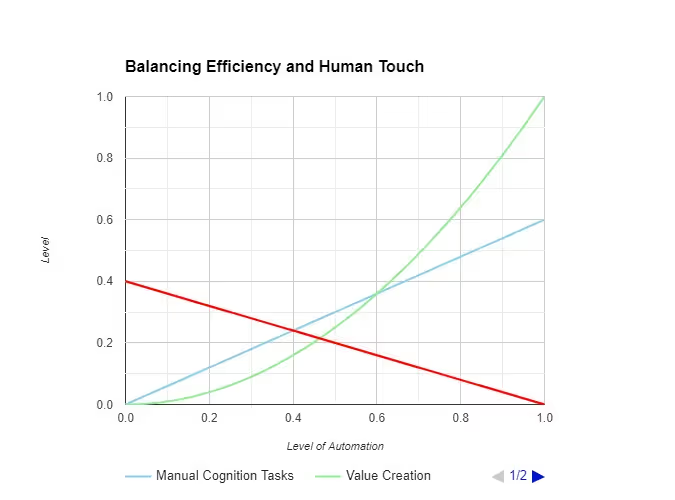The Future Role of Human Labor in Automation
The labor market is currently experiencing some apprehension regarding the impact of generative AI automation. This uncertainty is primarily due to a lack of clarity surrounding the creation of new job opportunities. However, this concern is expected to be short-term, as the demand for human labor is anticipated to rise in the third quarter of 2024. This expected increase is because while automation can provide significant value for repetitive tasks, its benefits are further enhanced when combined with manual cognitive workloads.
Here are some examples of Automated and Manual Cognition workloads across the functions
Manufacturing:
Automated: Robots assemble cars on the production line, significantly increasing efficiency and quality.
Manual Cognition: Humans must still design the robots, program their movements, and perform quality checks on the finished vehicles.
Customer Service:
Automated: Chatbots answer simple customer queries and gather information, freeing up human agents for more complex issues.
Manual Cognition: Human agents must handle escalated issues, offer personalized advice, and build customer rapport.
Marketing:
Automated: Email automation sends targeted campaigns based on customer data.
Manual Cognition: Humans must still develop creative content, analyze campaign performance, and adjust strategies for optimal results.
In the graph below, the Red Line describes the decrease in Repetitive tasks, while the Blue line shows the increase in the Manual Cognition Workloads. The combination of Automation and Manual Cognition creates the Value Creation (Green Line)

To accurately determine the role of humans in the workforce, it is crucial to delineate the various workloads and associated skill clusters. Consider the example of the increasingly popular field of Prompt Engineering. This area encompasses several distinct aspects, such as Prompt Design, which involves crafting effective and precise prompts to guide AI responses; Prompt Tuning, which focuses on refining and optimizing prompts to achieve desired outcomes; and Prompt Hacking, which entails creatively manipulating prompts to explore new possibilities or overcome limitations. Each of these facets requires a unique set of skills and expertise, underscoring the importance of clearly defining workloads and skill clusters in the evolving landscape of human-AI collaboration.
Such a blue print would help HR define the role of Human in the future organization.

Overall, we are pretty excited about HR’s role under emerging circumstances. If we plan the initiatives correctly, we can accelerate transformation and adaptation and make the enterprises genuinely care for a great workplace. Thanks again for reading. Please stay safe; we will return with more insights next week.










.svg)




















.svg)





.svg)
